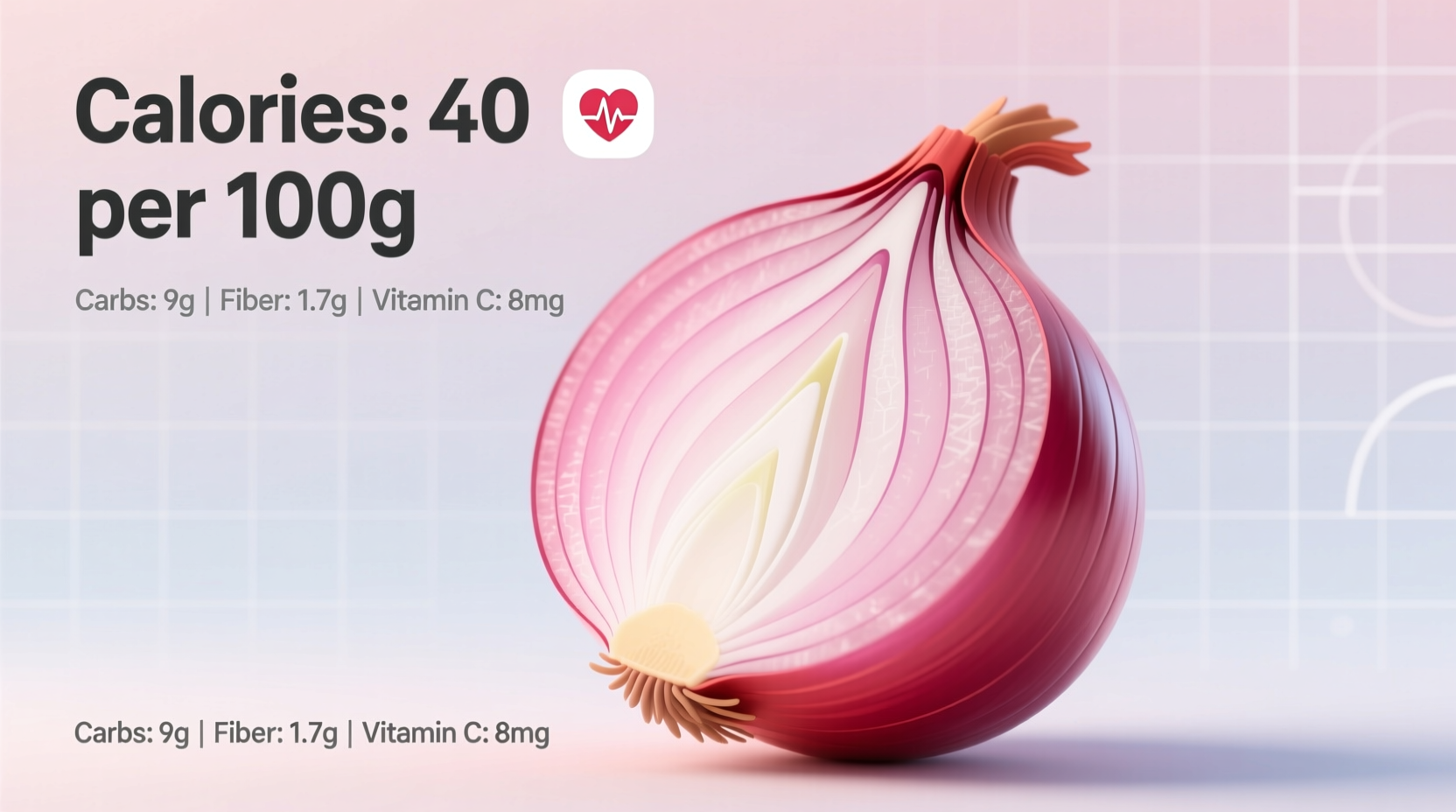Understanding the precise nutritional value of ingredients helps you make informed dietary choices without sacrificing flavor. Red onions aren't just colorful garnishes—they're nutritional powerhouses that can enhance both your meals and your health profile.
Nutritional Profile of Red Onions: Beyond Just Calories
When tracking your daily caloric intake, knowing exactly what you're consuming matters. According to the USDA FoodData Central database, the calorie content of red onions breaks down as follows:
| Red Onion Size | Calories | Carbohydrates | Fiber |
|---|---|---|---|
| 1 cup chopped (160g) | 64 | 15g | 2.7g |
| Medium onion (110g) | 44 | 10g | 1.9g |
| 1 tablespoon (10g) | 4 | 1g | 0.2g |
This nutritional data comes directly from the USDA's comprehensive food composition database, which scientists and nutrition professionals rely on for accurate dietary information. Unlike many online sources that provide inconsistent numbers, the USDA database represents laboratory-verified measurements.
How Red Onions Compare to Other Onion Varieties
Many people wonder if different onion types vary significantly in calorie content. The truth is, most onion varieties have remarkably similar caloric profiles, but red onions offer unique nutritional advantages:
- Calorie comparison: Yellow onions (42 calories per medium), white onions (43 calories), red onions (44 calories)
- Antioxidant advantage: Red onions contain anthocyanins, the same powerful antioxidants found in blueberries and red cabbage
- Vitamin C content: Red onions provide about 11% of your daily vitamin C needs per medium onion, slightly more than yellow varieties
A 2022 study published in the Journal of Agricultural and Food Chemistry confirmed that red onions contain up to six times more antioxidants than yellow or white varieties. This doesn't affect calorie count but significantly enhances their nutritional value.

Practical Applications: Using Red Onion Calories in Your Diet
Knowing the calorie count is just the beginning—understanding how to incorporate red onions effectively matters more for your dietary goals:
For Weight Management
With only 4 calories per tablespoon, red onions add substantial flavor and texture to meals without significantly impacting your daily calorie budget. They're particularly valuable because:
- They increase meal volume without adding calories (a principle known as volumetrics)
- Their natural sweetness can reduce the need for added sugars in recipes
- Fiber content promotes satiety, helping you feel full longer
Culinary Considerations That Affect Calorie Impact
How you prepare red onions influences their nutritional contribution:
- Raw: Preserves all nutrients and maintains the 44-calorie count for a medium onion
- Grilled or roasted: Water content reduces, concentrating flavors but not increasing calories
- Caramelized: Natural sugars concentrate, but calorie count remains similar unless added fats or sugars are used
Professional chefs like Antonio Rodriguez emphasize that "the beauty of red onions is how their low-calorie profile doesn't compromise flavor impact. A few slices can transform a salad, sandwich, or taco without derailing your nutritional goals."
Context Matters: When Red Onion Calories Become Significant
While red onions are naturally low-calorie, certain dietary contexts make their nutritional profile particularly valuable:
- Diabetes management: With a low glycemic load of 1-2, red onions won't spike blood sugar
- Keto diets: At 10g net carbs per medium onion, they can fit within daily carb limits when portion-controlled
- Low-FODMAP diets: Smaller portions (30g) are generally tolerated, providing flavor without digestive issues
Nutrition researchers at Harvard T.H. Chan School of Public Health note that "the minimal calorie contribution of onions makes them an excellent vehicle for increasing vegetable consumption without significantly impacting energy intake—particularly valuable for those managing weight while trying to increase nutrient density."
Common Misconceptions About Onion Calories
Several myths persist about onion nutrition that deserve clarification:
- Myth: Cooking significantly increases onion calories
Fact: Cooking concentrates flavor but doesn't add calories unless fats or sugars are introduced - Myth: Red onions are higher in sugar than other varieties
Fact: Sugar content is similar across varieties, but red onions' anthocyanins create a perception of greater sweetness - Myth: Onion calories come primarily from sugar
Fact: Most carbohydrates in onions are complex fibers rather than simple sugars
Maximizing Nutritional Benefits While Tracking Calories
To get the most from red onions while monitoring your calorie intake:
- Use raw red onions in salads and salsas to preserve maximum antioxidant content
- Pair with healthy fats like olive oil to enhance absorption of fat-soluble antioxidants
- Store properly (cool, dark place) to maintain nutrient density longer
- Don't discard the outer layers—these contain the highest concentration of beneficial compounds
Registered dietitians often recommend keeping red onions on hand because their versatility allows for flavor enhancement across countless dishes without requiring significant calorie budget allocation.











 浙公网安备
33010002000092号
浙公网安备
33010002000092号 浙B2-20120091-4
浙B2-20120091-4